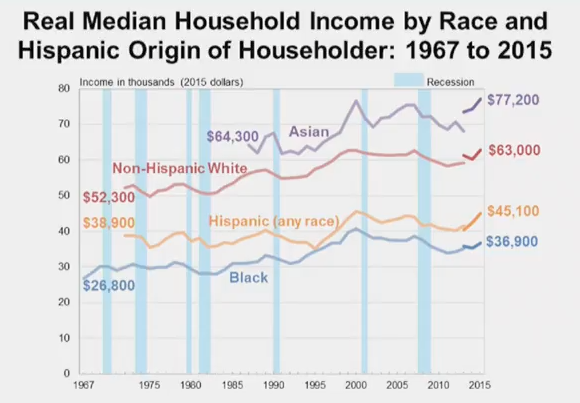Good news from the U.S. Census Bureau Tuesday, which released its national estimates on poverty, income and health insurance coverage for 2015.
The numbers painted a largely positive picture as employment and household incomes increased, while poverty rates decreased. Perhaps the biggest finding from the estimates: household median income increased 5.2 percent from 2014 to 2015, to roughly $56,500 -- the first annual increase in real median wages since 2007.
"It's one of the largest year-to-year increases in median household income that we've ever had," said Trudi Renwick, assistant chief division chief for economic characteristics in the social, economic and housing statistics division, in a press conference Tuesday morning.
"It's up really just across the board," she said. "It's up in all four regions; it's up for almost every age group of household heads; it's up for almost every racial group, except for Asians, so it's really a broad, broad increase in household median income.
The increase in incomes was linked largely to higher employment, with an increase of 2.4 million full-time, year-round workers in 2015. Poverty decreased from 14.8 percent in 2014 to 13.5 percent in 2015.
But within those broad national numbers, some groups and areas had larger gains than others, and many underlying inequities persisted.
For example, while Hispanic householders saw the greatest increase in median incomes -- at 6.1 percent -- they still fell behind national median incomes as well as median incomes for white and Asian householders.
Similarly, Hispanic populations also saw the greatest increase in health insurance coverage with a 3.6 percentage point increase while still having the highest uninsured rate overall, at 16.2 percent. When it came to income inequality, federal officials said there was no statistically significant change from 2014, and the average earnings of women workers compared to male workers remained at just 80 percent.
Regionally, there were also significant differences. While median household incomes increased in all regions, the West saw the greatest gains with a 6.4 percent increase, and the South saw the least movement, with an increase of only 2.9 percent.
When it came to health insurance coverage, again, coverage was largely up, but states that chose not to expand Medicaid eligibility under the Affordable Healthcare Act lagged far behind states that did. Texas, which did not expand Medicaid eligibility, had the highest uninsured rate in the country at 17.1 percent. Only four other states had uninsured rates above 13 percent, including Florida and Georgia.
What could this mean for Texas? Most measures show Texas faring fairly well after the recession. Incomes and employment have tended to compare favorably to other states, but health insurance coverage has been a particular area of concern Even though Hispanic populations saw such large gains in health insurance coverage nationally, because Texas did not expand Medicaid eligibility, those gains will likely be less robust here. A report released in July from the Baker Institute found that nearly a third of Hispanics ages 18 to 64 in Texas were without health insurance.
Medical expenses have a large impact on families' economic health as well. Because the Census also tracks its own supplemental poverty measure that takes medical expenses into consideration, it's possible to see the number of people who are in poverty who otherwise wouldn't be due to medical costs.
In 2015, that number was 11.2 million people. In Texas, a state that is 40 percent Hispanic, that gap in health insurance coverage could have significant implications on poverty. More detailed local estimates will be released Thursday.





